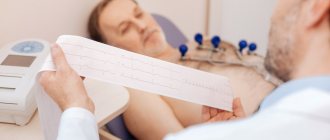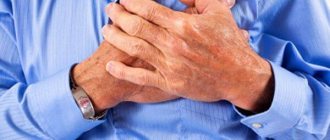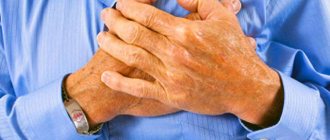Bradycardia
Bradycardia is a type of cardiac arrhythmia characterized by a slowing of the heart rate to 55 beats per minute or lower. It is the norm for athletes who systematically experience significant physical activity. In this case, we talk about physiological (functional) bradycardia. However, more often it is pathological in nature and serves as a symptom of heart disease. This condition is based on the inability of the sinus node to produce electrical impulses more than 60 times per minute, or to distribute them correctly along the conduction pathways.
Prevention
First of all, you need to be regularly monitored by a cardiologist in order to recognize the pathology in time. In addition, preventive measures include:
- control blood pressure and bring it to normal;
- maintaining adequate weight;
- regular physical activity appropriate for age;
- diet;
- choosing foods high in vitamins and minerals that are good for the heart;
- limiting smoking and alcohol;
- if possible, minimizing stressful situations;
- good sleep, rest and relaxation.
Bradycardia is a symptom that may indicate the presence of serious diseases. Under no circumstances should it be ignored. A timely visit to the doctor will help to avoid complications and begin appropriate treatment in time if necessary.
FIND OUT PRICES
Types of bradycardia and causes of its occurrence
According to its localization, pathological bradycardia of the heart can be:
- sinus. Appears due to a malfunction of the sinus node;
- caused by heart block. In this case, the sinus-atrial or atrioventricular conduction of impulses is disrupted.
Sinus bradycardia, depending on the causes that provoked it, is divided into the following forms:
- Organic. Appears as a result of any cardiac pathology: dystrophy or myocardial infarction, cardiosclerosis, myocarditis.
- Neurogenic (not associated with heart disease). This form can be caused by many factors: increased intracranial pressure, brain tumors and brain hemorrhages, various neuroses, vegetative-vascular dystonia, head bruises, wearing an excessively tightly tied tie or tight collar. Bradycardia is typical for patients with reduced thyroid function. Its cause may be a stomach or duodenal ulcer.
- Medicinal. This form is caused by taking certain medications, in particular, cardiac glycosides, morphine, β-blockers, calcium channel blockers, etc.
- Toxic. Develops with severe intoxication due to sepsis, typhoid fever, uremia, hepatitis. Toxic bradycardia is caused by poisoning with phosphorus compounds.
Sometimes the cause of the slow heart rate cannot be determined. This form is called idiopathic.
Cardiac bradycardia in a child or adolescent is usually caused by the same causes as in an adult. Such children require systematic monitoring by a cardiologist.
Women sometimes develop sinus bradycardia during pregnancy. This is a temporary condition that is not considered a pathology and goes away on its own after childbirth.
Types of pathology
Cardiologists distinguish five forms based on etiology:
- extracardiac;
- organic;
- medicinal;
- toxic;
- sinus sports.
The extracardiac type develops under the influence of neurogenic factors, the organic type develops against the background of pathological lesions of the heart. Medicinal and toxic forms of the disease occur when the patient enters the body of toxins or medications in excessive dosages. Sinus bradycardia in athletes is the result of many years of training aimed at achieving maximum heart rate during physical activity.
Pathological types can occur in acute or chronic forms. In the first case, the cause of heart rate disturbances are heart attacks, myocarditis, and intoxication. Chronic bradycardia becomes the result of age-related sclerotic lesions of the heart muscle.
Clinical picture
Mild bradycardia (45–55 beats per minute), which does not cause significant disturbances in the body, is usually not accompanied by clinical manifestations. Symptoms such as dizziness, weakness and fainting occur when the heart rate drops to 40 beats per minute.
In addition, when the heart rate slows down, you may experience:
- chronic fatigue;
- dyspnea;
- cold sweat;
- chest pain;
- blood pressure surges;
- problems with attention, thinking and memory;
- flashing “flies” before the eyes.
In severe cases, fainting and episodes of loss of consciousness are possible. The severity of bradycardia symptoms depends on the degree of circulatory disorder developing against its background.
Procedures and operations
In some cases, to treat bradycardia it is necessary to resort to surgical treatment:
- removal of tumors and neoplasms of the mediastinum;
- implantation of a pacemaker .
Main indications for pacemaker implantation:
- atrial fibrillation and atrial flutter with a pulse less than 50 beats per minute;
- sick sinus syndrome with circulatory failure of III-IV degree or episodes of Morgagni-Adams-Stokes attacks;
- AV blockade IIb-III degree , which cannot be corrected and occurs 3-4 weeks after myocardial infarction;
- acquired AV block of IIB-III degree with episodes of Morgagni-Adams-Stokes attacks or circulatory failure of III-IV degree.
Relative indications for pacemaker implantation:
- chronic bi- and trifascicular blockade;
- congenital complete AV block in adults with 3rd degree circulatory failure;
- congenital AV block with circulatory failure of 3-4 degrees or SSU with episodes of Morgagni-Adams-Stokes attacks;
- an increase in the width of the QRS complex on the ECG by more than 0.8 s and a prolongation of the HR interval by more than 100 ms.
The pacemaker is selected individually depending on the degree of hemodynamic disturbances and the causes that caused them.
Diagnostics
The main symptom of the pathology in question is a rare pulse. With sinus bradycardia, heart contractions have a regular rhythm. The sonority of heart sounds remains unchanged. Some patients experience irregular breathing.
To clarify the diagnosis, the doctor prescribes additional tests:
- ECG;
- ultrasound sonography of the heart;
- bicycle ergometry with load;
- transesophageal electrophysiological study of cardiac conduction tracts.
The latter method allows you to differentiate the functional and organic forms of heart rhythm disturbances.
Causes of heart rhythm disturbances
The organic type manifests itself against the background of several pathologies:
- myocardial infarction;
- myocardial dystrophy;
- myocarditis;
- cardiosclerosis.
The listed diseases provoke degenerative changes in the sinus node and conduction disturbances in the myocardium.
The extracardiac form of bradycardia is the result of neuroses, increased intracranial pressure or compression of the carotid sinus by clothing.
Toxic lesions develop when a person comes into contact with hazardous chemicals. Bradycardia of this type often develops against the background of the patient’s professional activity.
Drug-induced bradycardia occurs when a person violates the prescribed dosage of a drug or long-term use of medications with a pronounced effect on the heart rate.
Treatment of bradycardia
Physiological and mild types of pathology that do not cause much discomfort to the patient do not require therapy. If the decrease in heart rate is caused by medications, then dose adjustments or drug replacement are carried out. All other forms are eliminated with medication. The basis of treatment should be to eliminate the problem that caused the slow heart rate.
Symptoms associated with cerebral hypoxia are relieved by products containing belladonna (Bellaspon, Bellataminal, Besalol, Zelenin Drops), Eleutherococcus extract, ginseng root, and caffeine.
Drugs that can increase heart rate include:
- "Atropine sulfate";
- "Izadrin";
- "Normosecretol";
- "Orciprenaline sulfate";
- "Ephedrine hydrochloride."
Injection solutions and tablets for bradycardia are selected by the doctor, taking into account the clinical picture, contraindications, the patient’s age and concomitant diseases.
Diagnostic measures
The diagnosis of bradycardia is beyond doubt. In order to clarify the heart rate and the threat to life, electrotocography and cardiac ultrasound (EchoCG) are sufficient. If necessary, a number of clarifying studies are prescribed: a biochemical blood test, a general urine test, and a blood sugar test. Bradycardia can be suspected based on the results of auscultation, but this method alone is not enough.
First aid for an attack
If there is a person with bradycardia in the family, it is important for loved ones to understand how to help if an attack occurs. When the heart rate drops to critical values, the following measures are indicated:
- give strong black tea or coffee to drink;
- brew a strong decoction of belladonna or ginseng;
- help lie on your back, raise your head and legs;
- give a tablet of Nitroglycerin or Izadrina under the tongue.
If the patient has difficulty breathing, it is necessary to free the chest from clothing and provide a flow of fresh air into the room. If after 5–10 minutes there is no relief, the patient begins to complain of a burning sensation and pain behind the sternum, cold sweat covers the forehead, it is important to urgently call an ambulance. While the team is traveling, the patient is helped to collect documents and things for hospitalization.
Treatment tactics
Treatment of bradycardia is situational. The tactics are chosen based on examination data and the study of the patient’s life and clinical history. Initial and moderate degrees of bradycardia do not require drug correction in the absence of clinical manifestations. In case of persistent bradycardia, dynamic monitoring is indicated in order to promptly respond to deterioration of the condition.
Indications for starting corrective treatment are a slowdown in heart rate, hemodynamic disturbances, the development of angina pectoris, and the addition of typical manifestations of severe bradycardia with episodes of convulsions, loss of consciousness, and arrhythmia. The main drugs for stabilizing heart rate are those based on caffeine, ephedrine, and isoprenaline. Herbal preparations include eleutherococcus roots, ginseng, and belladonna infusion. If bradycardia is caused by intoxication, elimination of the provoking factor is indicated.
In severe cases, the patient is advised to have a pacemaker installed. Implantation of the device allows you to maintain an optimal level of heart rate, at which hemodynamics are stable. Surgical treatment is indicated only when there is a persistent decrease in heart rate, when there is a significant effect on hemodynamics, the patient’s quality of life worsens, and there is a real threat to life and health.
Prognosis and prevention
The prognosis for timely treatment and adequate monitoring of patients with bradycardia is favorable. The five-year survival rate reaches 95%. An unfavorable prognosis is made with organic damage to the heart and cardiac structures. Installation of a pacemaker significantly improves the quality of life of patients with bradycardia. Such patients require observation by a cardiologist, ECG and EchoCG at least once every 3 months, and when the condition is stabilized - at least 2 times a year.
Prevention of complications is aimed at relieving symptoms and improving the quality of life of patients. It is important to eliminate bad habits, especially smoking and drinking alcohol, and negative factors (harmful industries, unsatisfactory living conditions).
Be sure to avoid physical inactivity and go in for sports. Physical activity is unacceptable only in cases where bradycardia is caused by pathology and is incompatible with stress. In other cases, therapeutic exercises only improve the general condition. Patients are recommended to adjust their diet, sleep and rest patterns, and normalize their psycho-emotional background.
Complications
Moderate or mild cardiac bradycardia may not cause hemodynamic disturbances. However, a significant decrease in heart rate (up to 40 beats or less) leads to insufficient blood flow to vital organs and their oxygen starvation. As a result, serious damage to the brain, kidneys, liver, intestines, lungs and disruption of their normal functioning can occur.
The brain suffers the most from impaired contractile function of the heart muscle (myocardium) and insufficient blood supply. Its hypoxia causes convulsions or episodes of loss of consciousness lasting up to a minute. This is the most serious complication, since breathing may stop during an attack. In case of frequent loss of consciousness with a sharp drop in blood pressure, the issue of implanting a pacemaker is decided - a device that artificially generates electrical impulses with the required frequency.
What is its danger?
Due to the weakening of the contractile function of the myocardium and the slowing of blood circulation, the brain, which experiences hypoxia (oxygen starvation), reacts first. Therefore, bradycardia can lead to attacks of loss of consciousness and convulsions, which can last from several seconds to 1 minute. This is one of the most dangerous conditions with bradycardia, which requires emergency medical measures. If assistance is not provided in a timely and correct manner, respiratory activity may stop.
Frequently asked questions about bradycardia
What medications can be taken for bradycardia?
If you begin to notice a slowing of your heartbeat, then rush to see a doctor to determine the cause. Medicines are prescribed depending on the origin and type of pathology. Do not try to stop a sudden attack of acute bradycardia on your own. Better call an ambulance.
What causes bradycardia?
There may be several reasons for a decrease in heart rate. The leading place among them is occupied by organic heart lesions. Disorders of the nervous system, diseases of the thyroid gland and stomach, and the use of certain drugs can also provoke a slowdown in heart rate. Sometimes bradycardia is accompanied by severe poisoning.
What to take if your heart rate is low?
For mild sinus bradycardia, it is enough to drink “Zelenin Drops” 2-3 times a day, 20-30 drops with water. If bradycardia is accompanied by painful symptoms and does not go away, then you cannot do without medical help.
Pathogenesis
The mechanisms of development of bradycardia are different, and most of them are associated with pathology of the sinus node , the main pacemaker. The main pulse generator of the heart is located in the right atrium. Bradycardia can be considered a normal variant in athletes and people who simply exercise regularly.
Pathological bradycardia can form against the background of abnormal functioning of the sinus node or as a result of changes in the conduction system of the heart. In the first case, the reason lies in the incorrect generation of impulses from the sinus node, and in the second, after the normal generation of impulses, they are incorrectly distributed among the parts of the heart, which is reflected in the slowdown in contraction of the atria and ventricles.
Prevention, how to increase heart rate during bradycardia
The development of bradycardia can be avoided if you adhere to certain rules:
- refusal to drink alcoholic beverages and cigarettes;
- eat healthy foods and fresh produce;
- monitor blood cholesterol
- do not overeat;
- visit a doctor, undergo medical examinations and preventive examinations;
- get enough sleep and organize proper rest;
- reduce salt intake;
- avoid depression and stressful situations.
Only by taking good care of your own body can you avoid the development of heart pathology. If you feel that a rare heartbeat is worsening the quality of your life, then you should contact a therapist and cardiologist who will help conduct examinations and prescribe adequate timely treatment. Remember that in the absence of proper therapy, sinus bradyarrhythmia can not only worsen overall health, but also lead to such negative consequences as thrombosis , heart failure , etc.
Bradycardia in the fetus during pregnancy
During a routine examination, fetal bradycardia may be detected. If the number of heartbeats of the embryo is less than 110 beats per minute, then this is considered a pathology. An insufficient number of heart contractions negatively affects the blood circulation of the fetus and, accordingly, its growth and development. The embryonic heart begins to develop from the second week of pregnancy.
With fully formed heart chambers, bradycardia can be diagnosed at 6-8 weeks. Fetal bradycardia during pregnancy 6 weeks is a relative concept, because There are no clear standards for these periods. In the first stages of development, the embryo's heart contracts at a frequency of 40 beats. As veins, aortas and vessels form, the frequency begins to increase. By the end of the ninth week, the pulse reaches 175 beats per minute.
Bradycardia in a newborn
For infants, the norm is 100 beats per minute. The causes of bradycardia in newborns lie in pathological processes that occur in the heart muscle and myocardium. Most often, the reason also lies in hypertonicity of the vagus nerve. Some newborns are diagnosed with absolute bradycardia - a condition in which the rhythm is constantly slow and does not depend on any reason.
In the relative form of bradycardia, the rhythm slows down under the influence of certain factors, for example, hyperthermia . Moderate bradycardia in a newborn is considered a common phenomenon and is characterized by a slowdown in heart rate during exhalation, which is especially pronounced during hypothermia. Pathology can be congenital or acquired.
Consequences and complications. Why is cardiac bradycardia dangerous?
Complications may develop with bradycardia:
- ischemic type stroke
- pulmonary embolism;
- paroxysmal ventricular tachycardia;
- myocardial infarction.
The most dangerous complication is asystole - cessation of cardiac activity. Bradycardia is dangerous because in the absence of adequate blood circulation for a long time, ischemic changes are formed in the brain, which can lead to death.











